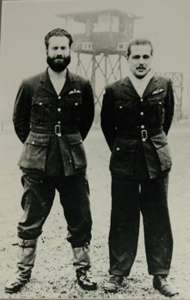
A donation to the Drumheller Legion last week helped shed light on a fascinating chapter in the history of World War II, and cemented a local connection to one of the most famous stories of courage that came out of the conflict.
Former Drumheller resident Joe Hautzinger presented the Legion with a print called Stalag Luft III Tunnel Martyrs. Alberta artist Bill Holder completed this work, commissioned by The POW Association of Canada, in 1998. The donation was made in the memory of Joe’s uncles Vic and Ed Hautzinger, both servicemen.
The print was commissioned in dedication of the 50 men who were executed following what is best known as The Great Escape. This conjures up images of Steve McQueen bouncing a baseball against the wall of a solitary cell, or blasting across the countryside on a Triumph motorcycle pursued by German soldiers.
The real story is less Hollywood, and more hard work, organization and eventually tragedy. About 80 escaped from the air force prison camp, three made it to freedom, while the rest were eventually rounded up. Fifty of the men were executed.
In the process of making the donation, the Legion’s Sergeant at Arms Ed LaPlante pointed out a photo, which has been on the Legion’s wall for years. It is a photo of former Drumheller man Harlie de Forest and a Calgary Airman at Stalag Luft III.
The Mail combed its archives to learn more about de Forest and his service, and found in the pages of The Mail, the story of a young man who joined up, trained as a pilot, was captured and spent most of the war imprisoned. While he was not one of the men who travelled through the tunnel, it appears he was aware of the project and came home to do presentations on the escape.
Harlie de Forest is the son of Mr. and Mrs. L.G. de Forest. We first learned of his service in the May 18, 1939 edition of The Drumheller Mail. There is a note that he would be sailing on June 16 of that year to England to join with the Royal Air Force.
In July, his parents received correspondence from de Forest. This appeared on the front-page of the July 13 edition and the young man was getting acquainted with the English countryside as he began his training at the de Havilland School of Civil Flying near Maidenhead.
His training went well and in the August 24 edition it was reported he had been awarded his licence as an “A” private pilot, and by the September 21 edition, his class was the first to fly an Anson Bomber solo. This was the first correspondence they received since the declaration of War. At that time, de Forest expected he would be on patrol duty within two months.
He went into active service as a pilot and flew a number of missions. In one mission he was grazed by a bullet and received a flesh wound. On his next trip he crashed and his arm had to be broken and reset.
A particularly chilling story came from the front page of the December 19, 1940 edition of The Mail when it was learned that de Forest had been reported missing during a mission on December 4. His family received cables from England on December 13 that a German radio broadcast said that he was taken prisoner, however at the time there was no official confirmation.
In the January 2, 1941 edition it was confirmed he was taken prisoner.
de Forest later accounted the December 4 mission. Aboard a Wellington Bomber he took off from England in cloud cover at 5 p.m. When the clouds broke they revealed the Alps in front of them. The crew tried for a half an hour to gain enough altitude to cross the mountains but were unsuccessful. The plan was to fly back to England and hope to find a target on their return trip.
Again clouds obscured their view, and when they estimated they were back above England they began to descend. They were guided by a search light to an aerodrome. The plane taxied, guided by a man with a flashlight to a muddy area. de Forest exited the plane only to hear German spoken. The plane was in France. The crew was able to set fire to their craft before being captured.
The first camp de Forest was sent to was at Barth, on the edge of the frozen Baltic. In 1942, he was among 200 prisoners who were moved to the newly built Stalag Luft III.
While the hardship of life in a POW camp cannot be underestimated, Stalag Luft III was known to have the best recreational program of any camp. There were athletic fields, a swimming pool and the prisoners were even able to build a theatre. There were also education programs.
Communication was also open and the de Forest family in Drumheller received dispatches from their son, including one where he was actively studying languages and music. He received care parcels from home regularly. One entertaining entry came in the “Smile when we think of column” in the January 13, 1944 edition of The Mail.
“SCANNING a picture of Allied flyers who sported masquerade costumes for entertainment to provide lighter moments in a prisoner of war camp in Germany! Prominent among the musicians was Flight-Lieut Hardie de Forest (beard and all). A female impersonator caught the eye. Holy mackerel! What legs! Marlene Dietrich would have run a poor second.”
In May 31 1945, it was reported that prisoners had been released, and by August 18 de Forest was home to be greeted by his family.
In October, de Forest’s story was shared with the residents of Drumheller. At a meeting of the Rotary Club, de Forest spoke of his capture and imprisonment including building the theatre.
He also delved into “The Great Escape.” He explained the organization, how the tunnel was constructed and how the sand was disposed of without it being noticed. He backed up his story with his personal logbook of his experience chock full of drawings, photos and diagrams.
While it was not known how involved de Forest was with the plot, it is an amazing story to learn that a young Drumheller man was part of one of history’s most spectacular war stories.




















